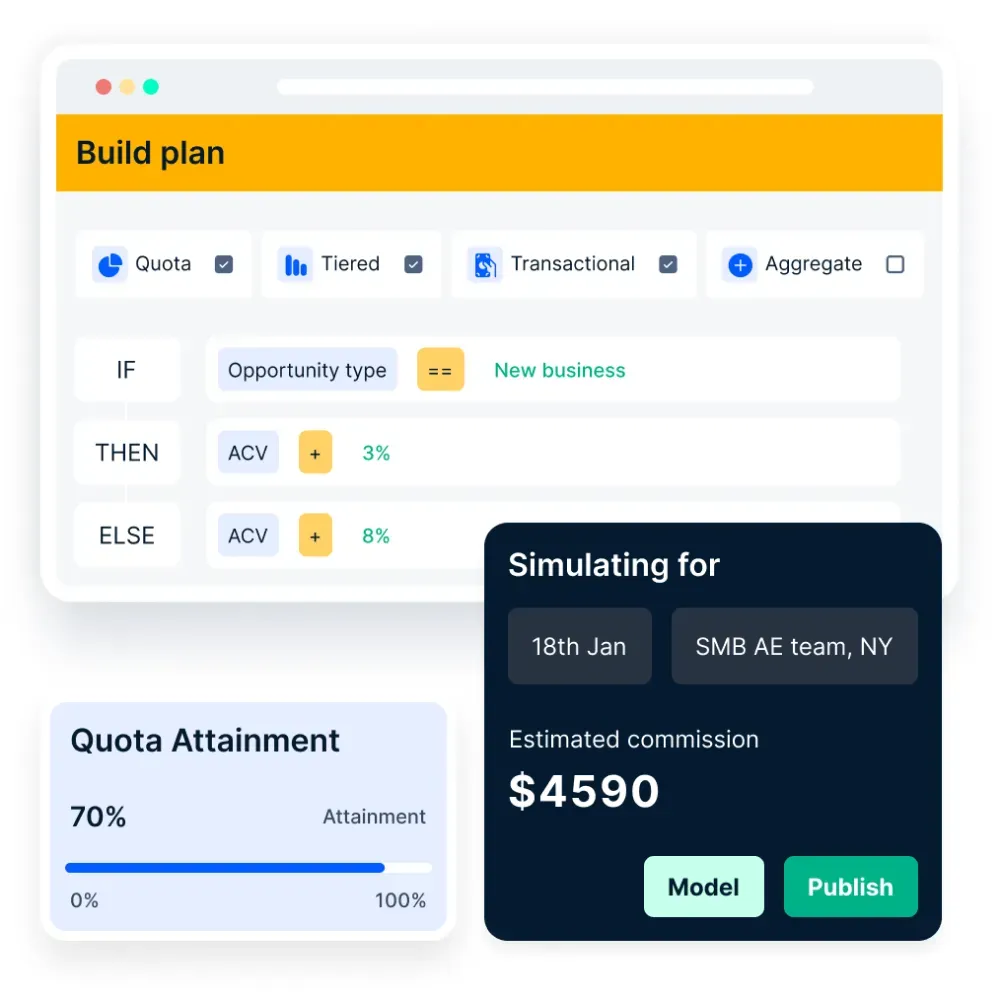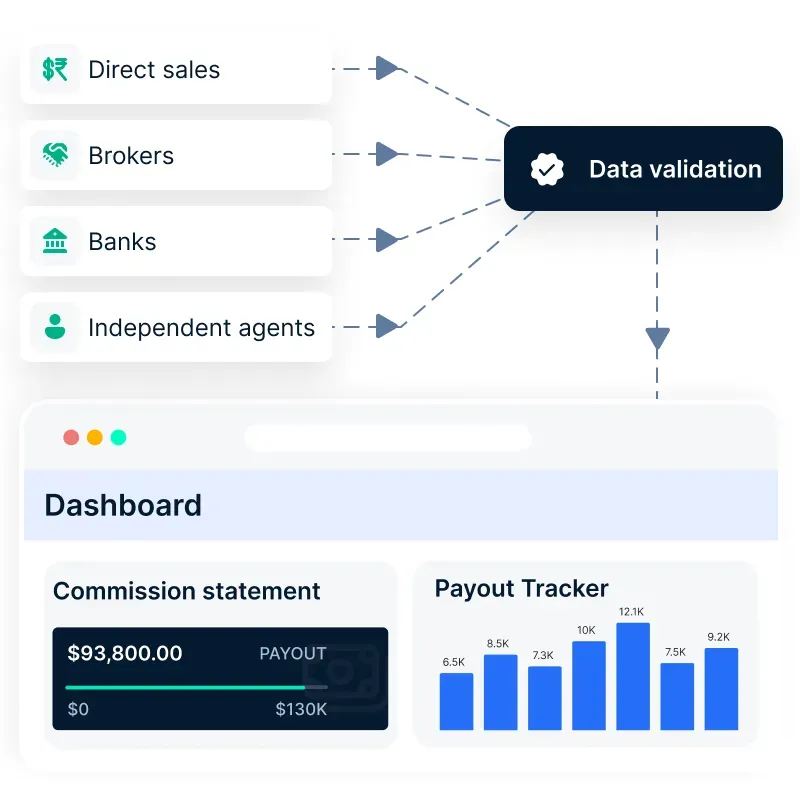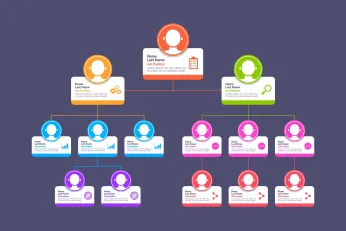في هذه الصفحة
A well-structured sales incentive compensation program is a powerful tool for driving revenue growth and enhancing sales team performance. When designed effectively, these programs align sales behaviors with business objectives, motivating reps to exceed targets while ensuring long-term profitability. However, simply offering incentives is not enough—following sales incentive programs best practices is crucial to maintaining engagement and productivity.
Companies that implement best practices in sales incentive plan design create transparent, data-driven compensation structures that reward high performance while promoting sustainable sales growth. Research shows that engaged and motivated sales teams contribute to higher profitability and reduced turnover, making strategic incentive planning a business necessity. This blog will share best practices in sales incentive planning and compensation.
ما هو تعويض حافز المبيعات؟
Incentive compensation is additional money sales representatives earn on top of their regular base salary and bonuses whenever they close a deal or achieve a specific business objective.
A representative might be earning a commission or a bonus, but mostly this is given out as cash and forms a part of his existing compensation plan.
On the other hand, sales incentive compensation is designed to stimulate certain behaviors in the sales teams, which undoubtedly enables higher sales and serves as a tool for motivation and recognition.
It has an intrinsic value that extends beyond monetary worth. Recipients view this compensation as celebratory, with a sense of appreciation and recognition, making them more memorable.
This incentive can take many forms and may include noncash rewards like prizes, tickets, annual family holiday packages, team holidays, etc. With a properly designed and delivered sales incentive compensation plan, salespeople maximize their rewards, and the organization maximizes revenue.
The best sales incentive plan for your organization should be simple enough for the sales reps to understand its working so that they take necessary actions to hit their goals.
How does incentive compensation management work?
Incentive compensation management automates commission and bonus calculations, providing real-time tracking for sales reps to monitor earnings and payouts. The right system simplifies plan administration, making updates and adjustments seamless.
For effective implementation, incentive programs must align with business goals and sales strategies. A well-designed plan ensures that variable compensation reflects performance, driving motivation and results. Integrating this software with a sales CRM enhances visibility, helping reps understand their earnings and performance metrics.
Managing incentive compensation manually is complex and prone to errors, leading to miscalculations, payment delays, and disengaged sales teams. Compass automates the entire incentive compensation management (ICM) process, ensuring real-time tracking, accurate payouts, and seamless plan administration.

With Compass’s no-code platform, businesses can design, publish, and manage incentive plans for any role without requiring technical expertise. Additionally, hierarchy-based approval workflows ensure that earnings approvals, escalations, and disputes are handled efficiently, eliminating miscommunication between teams.
Why is incentive compensation management important?
Effective incentive compensation management is key to driving performance and retention. It ensures fair, transparent pay structures that align team behavior with company objectives. By automating processes, businesses reduce errors and save time.
- Aligns sales efforts with company objectives.
- Boosts morale and retention with clear, fair compensation.
- Reduces errors and saves time by automating manual processes.
- Attracts top talent with structured, competitive pay plans.
- Enhances forecasting and financial planning through accurate tracking.
Without efficient compensation tracking, businesses risk errors, inefficiencies, and disengaged sales teams.
Errors and inefficiencies in incentive management can lead to financial losses, disengaged employees, and disputes. Compass eliminates manual miscalculations and ensures error-free payouts by automating commission tracking.
Its flexible data management seamlessly integrates with leading CRMs, ERPs, HRMs, and Payroll systems like HubSpot, SAP S/4HANA, Workday, Zuora, QuickBooks, Salesforce, Zoho CRM, Sage, and Google Sheets, providing a fully connected and automated workflow.

By leveraging real-time tracking and automated calculations, Compass helps businesses improve accuracy, enhance transparency, and reduce administrative overhead.
Specific types of incentive compensation
Organizations use various types of incentive compensation to drive performance and engagement. Here are some common examples:
- Performance-based bonuses reward employees for achieving specific goals. For example, a marketing manager may receive a bonus for increasing website traffic by 20% in a quarter.
- Restricted stock units (RSUs) grant company stock that vests over time. A tech company might offer RSUs to software engineers as part of their compensation package to encourage long-term commitment.
- Profit-sharing bonuses distribute a portion of company profits to employees. A manufacturing firm, for instance, might give annual bonuses based on company earnings to all employees.
- Commission-based pay provides a percentage of sales revenue. A car salesperson earning 5% commission on every vehicle sold is a common example of sales incentive compensation.
Some organizations use a single incentive type, while others combine multiple forms. Finding the right mix ensures employees stay motivated and aligned with company goals.
كيف يتم تصميم خطط تعويض حوافز المبيعات؟
Typically, in most organizations, sales leadership and sales operations teams create and manage the sales incentive compensation plan. They take valuable inputs from functions like finance, marketing, IT, and HR on other important parameters aligned with organizational goals and sales metrics. During the designing and adoption process, the plan may be revised multiple times and re-assessed basis disputes on buy-in from the wider sales team, business environment, and overall effectiveness.
مع وجود العديد من المقاييس التي يجب تتبعها ، والحسابات المعقدة ، وإدراج مجموعة متنوعة من التخصيصات ، فإن تصميم تعويض الحوافز هو بلا شك مهمة شاقة. أضف إلى ذلك الحاجة إلى الرؤية في الوقت الفعلي ، ولوحات المعلومات سهلة الفهم ، والرؤى ، فإن فريق تصميم الحوافز في رحلة صعبة. من المفيد ملاحظة هذه المبادئ الأساسية الثلاثة المذكورة أدناه أثناء تصميم خطة تعويض الحوافز:
المبادئ التنظيمية
تتعلق هذه المبادئ بربط خطط الحوافز بأهداف الشركة الأكبر. إنه ينطوي على
- تخصيص وزن مناسب لكل هدف وقياسه بدقة
- بما في ذلك المرونة في تكييف خطة الحوافز مع أي تغييرات في السوق ، أو تغيير في أهداف العمل
المبادئ التحفيزية
تربط هذه المبادئ خطط الحوافز بالتخصيص في القيمة والدور في المنظمة. قد تشمل هذه
- توفير حوافز أكثر عاطفية (الشعور بالإنجاز ، الوضع الاجتماعي) من مجرد النفعية
- استخدام الخوارزميات التنبؤية لتقدير أهداف المبيعات الفردية بدلا من نفس النسبة المئوية للزيادة للجميع
المبادئ السلوكية
تربط هذه المبادئ خطط الحوافز لتشجيع السلوك المرغوب فيه لدى الأفراد والفرق. يؤدي إلى
- التحفيز على تحسين جودة العملاء المحتملين بدلا من مجرد مطاردة الأرقام المستهدفة
- مقاييس مثل انخفاض شكاوى العملاء مقارنة بالربع الأخير
بمجرد الانتهاء من خطة تعويض حوافز المبيعات ، يجب إبلاغها جيدا داخل المنظمة. التواصل الضعيف لخطة رائعة أسوأ من التواصل الجيد لخطة متواضعة. هناك حاجة للتدريب عبر الإنترنت ، ووثائق الأسئلة الشائعة ، وقناة مفتوحة للإجابة على شكوك فريق المبيعات بمجرد الانتهاء من طرح خطة حوافز المبيعات.
نظرا لأن التكلفة العالية متضمنة في أي تعويض تحفيزي وإمكاناتها الكبيرة لدفع سلوك المبيعات ، فإن تعظيم عائد الاستثمار على تعويض الحوافز أمر بالغ الأهمية للشركات. لكن عائد الاستثمار على خطط الحوافز هو عائد مالي أعلى على النفقات الرأسمالية ولكن له تأثير عام على المنظمة ، بدءا من فرق المبيعات ذات الدوافع الاستراتيجية إلى انخفاض الاستنزاف إلى المدفوعات في الوقت المناسب وحتى تنبؤات الأعمال الأفضل.
ليس من السهل حساب عائد الاستثمار الذي تولده خطة الحوافز. للحساب من الناحية النقدية ، يمكنك إلقاء نظرة على زيادة في الإيرادات (و / أو حصة السوق المكتسبة ، وعدد العملاء المكتسبين ، ومعدلات دوران المخزون ، وما إلى ذلك) وطرح التكلفة الإجمالية لتنفيذ البرنامج وإدارته. ولكن بالنسبة للتأثير غير النقدي ، تحتاج إلى تعيين مقاييس قياس الفعالية في البداية أثناء إنشاء خطة الحوافز الخاصة بك. على سبيل المثال ، يمكن لبعض العوامل غير الملموسة مثل اعتماد التدريب ، والتغيب ، ودرجات رضا الموظفين في الاستطلاعات ، وتكلفة فقدان أو اكتساب عميل جديد أن توفر القيمة المتصورة لخطة الحوافز وتؤثر على تحفيز مندوبي المبيعات.
تشير العديد من الدراسات التي أجرتها مؤسسة أبحاث الحوافز إلى أنه ليس هناك شك على الإطلاق في أن الحوافز تحتاج إلى تصميم حول أفضل أصولك - الأشخاص. عندما يتعاطف الناس مع المنظمة ويشعرون بالانتماء والاستماع إليهم ، فإنهم متحمسون جوهريا لأداء واجباتهم بشكل جيد ووضع قيمة أعلى وتقدير أعمق لمكافآت خطط تعويض الحوافز.
أفضل ممارسات المبيعات لزيادة عائد الاستثمار لتعويض حوافز المبيعات
To increase your ROI for Sales Incentive Compensation, here are four sales best practices to follow. Let’s explore each of these sales best practices in detail.
1. أتمتة للقضاء على الأخطاء
ليس من السهل تصميم خطة تعويض الحوافز. مع وجود العديد من الأدوار التي يجب تقييمها ، والحسابات الكبيرة ، والوقت المستغرق في جمع المعلومات عبر الفرق ، وإدارة المسار الرقمي للتغييرات والأحداث ، وما إلى ذلك ، لا بد أن تكون العملية اليدوية خاطئة.
إن عدم الدقة في الحسابات هو سيف ذو حدين - في كلتا الحالتين من المدفوعات الزائدة والدفع الناقص للتعويض ، تدفع الشركة ثمنا باهظا. يؤدي الدفع الزائد إلى خسارة مالية مباشرة للمنظمة وانخفاض في عائد الاستثمار. في المقابل ، يؤدي الدفع الناقص إلى انخفاض ثقة الموظفين ، وانخفاض أداء المبيعات ، وحتى تكلفة المعركة القانونية إذا رفع الموظف دعوى قضائية بسبب الدفع غير الدقيق!
When sales representatives doubt the payments being made to them, their time, which ideally should be spent selling and bringing more business, is wasted on shadow accounting. Many organizations provide automation of sales incentive plans and can help make the process efficient. Consider investing in an automated incentive compensation management solution if you plan to keep your sales teams motivated and achieve accuracy in payments.
Compass eliminates these errors with automated commission calculations, ensuring fair compensation and eliminating disputes. Sales teams can focus on selling rather than shadow accounting, increasing overall productivity.
2. تحقيق الكفاءة التشغيلية لخفض التكلفة
عندما يتم أتمتة نظام تعويض حوافز المبيعات ، يكون هناك انخفاض في عدد الموارد اللازمة لإجراء الحسابات اليدوية وتقليل وقت الحساب ، والذي يمتد إلى عدة أيام كل شهر.
الآن ، من خلال أتمتة سير العمل ، هناك تحسن في كفاءة النظام مع تقليل الوقت المستغرق في إدخال البيانات ، وتقليل مخاطر النزاعات المحتملة ، وتوفير التكاليف من حيث متطلبات الموارد الأقل.
Compass streamlines the sales compensation process, reducing manual workload, decreasing calculation time, and eliminating administrative inefficiencies. By automating data entry and workflows, organizations lower resource costs while improving accuracy and speed.
3. استخدام الرؤى الرقمية لتعزيز الأداء
Manual incentive calculations cannot provide advanced digital insights both to sales leaders as well as sales reps. With a digital representation of his personalized performance data and variable compensation on an automated sales incentive compensation model, a sales representative can easily understand the results, so he invests time improving his metrics and is more satisfied and less likely to leave the organization. Sales leaders have better insights in struggling areas for their sales reps and can coach their marginal performers better and personalize their coaching, leading to improved performance.
في عالم تنافسي ، يجب ألا تتجاهل الشركات الأدوات الرقمية التي يستفيد منها منافسوها. تعد أداة التخطيط الآلي لحوافز المبيعات والرؤى إحدى هذه الأدوات. توفر هذه الأداة رؤى بيانات قيمة حول الأعمال بشكل عام ، مما يساعد في التخطيط المستقبلي بشكل أفضل ويؤدي إلى زيادة أرقام المبيعات.
عندما يتم بالفعل إنفاق مبلغ كبير من المال على تعويض مندوبي المبيعات ، فمن الضروري قياس خطط الحوافز وتعويضات المبيعات الخاصة بك مع المنافسين لفهم ما إذا كنت تحصل على عائد مناسب على الاستثمار وتعلم أفضل الممارسات. تتيح الرؤى الرقمية تحليلا مقارنا سريعا وسهلا لتطبيق ما تعلمته على الأعمال في أي وقت من الأوقات.
Compass provides real-time digital insights into sales performance, quota attainment, and commission effectiveness.
Predictive analytics helps leaders set realistic and personalized sales targets.
Benchmarking tools compare incentive structures with industry standards, allowing for optimization.
Personalized dashboards give sales reps a clear view of their earnings, goals, and commission trends.
By adopting Compass’s data analytics, organizations gain better visibility into performance trends and ensure their incentive plans drive real revenue growth.
4. تحسين التوقيت
يعمل برنامج تعويض حوافز المبيعات الخاص بك كإصدار واحد من الحقيقة لمعلومات المبيعات حول الحسابات المنتشرة في جميع أنحاء المؤسسة. يساعد في توفير صورة مالية دقيقة لاتخاذ قرارات أفضل للأعمال.
يعمل برنامج تعويض الحوافز الرقمي على أتمتة العمليات الحسابية المعقدة ، ويجعل الوصول إلى المعلومات أسرع ، ومشاركة المعلومات أسهل عبر الوظائف ، وتمكين المرونة في صنع القرار. لا يحتاج الفريق المالي إلى الانتظار حتى نهاية الشهر للحصول على بيانات تكلفة التعويض ، ولكنها متاحة الآن عند الطلب. هذا يزيد من سرعة التنبؤ ودقته للمؤسسات.
لا أحد يريد أن يستثمر التكلفة في تعويض الحوافز ولا يزال في وضع غير مؤات. تمكن تقنيات تعويض الحوافز المتقدمة المؤسسات من تحسين عائد الاستثمار على هذه النفقات الضخمة ، والحفاظ على مشاركة فريق المبيعات لديها وتحفيزها بالحوافز الكافية ، ومواءمة استراتيجية المبيعات لنمو الأعمال. إنها تتيح الوضوح القائم على الحقائق وتستخدم الخوارزميات التي تتعلم مع إدخال المزيد من البيانات ، مما يتيح تنبؤات مستقبلية أفضل.
ضع في اعتبارك استخدام برنامج تعويض حوافز المبيعات الآلي لمؤسستك إذا لم تكن قد قمت بذلك بالفعل. ستعيش لترى العديد من النتائج المفيدة التي يمكن أن تقدمها.
Compass automates complex compensation calculations and provides instant access to commission data, ensuring timely and accurate payments.
Finance teams can access on-demand compensation reports instead of waiting until the end of the month, improving forecasting accuracy and business decision-making speed.
5. Automate to Eliminate Errors
Designing an incentive compensation plan is a complex task. With multiple roles to assess, large calculations, data gathering across teams, and managing a digital trail of changes, a manual process is prone to errors.
Inaccurate calculations lead to overpayment or underpayment, both of which harm the business. Overpayment results in financial losses and reduced ROI, while underpayment diminishes employee trust, decreases performance, and could even lead to legal disputes.
Sales representatives who question their payments waste valuable selling time on shadow accounting. Investing in an automated incentive compensation management solution ensures accuracy, reduces disputes, and keeps sales teams motivated.
Compass eliminates errors through automated commission calculations, ensuring fair compensation and reducing disputes. This allows sales teams to focus on selling rather than verifying payments, ultimately improving productivity.
6. Bring Operational Efficiency to Reduce Costs
Automating the sales incentive compensation system reduces resource allocation for manual calculations and significantly cuts down processing time. By automating workflows, organizations improve efficiency, lower the risk of disputes, and reduce costs associated with administrative work.
Compass streamlines the sales compensation process by reducing manual workload, decreasing calculation time, and eliminating inefficiencies. Automation lowers resource costs while improving accuracy and speed.
7. Improve Timeliness
An automated incentive compensation program provides real-time insights into financial data, facilitating better business decision-making. By eliminating delays in accessing compensation cost data, organizations can improve forecasting speed and accuracy.
Compass automates complex compensation calculations and provides instant access to commission data, ensuring timely and accurate payments. Finance teams can access compensation reports on demand, improving forecasting accuracy and decision-making speed.
Case Study: Automating Sales Commission for Asia’s Largest CNC Machine Manufacturer
The application of this best practice can be evident in the case study below.
طعن
A leading CNC machine manufacturer with 32+ global sales locations faced challenges in managing its sales commission process. The company needed a solution to:
- Provide real-time visibility into incentive calculations for sales reps.
- Reduce manual effort in commission processing.
- Eliminate reliance on sales leaders for handling commissions manually.
Solution: Compass Sales Commission Management
To address these challenges, the company implemented Compass, which:
- Automated commission calculations with real-time tracking.
- Provided gamification features (leaderboards, scorecards, quizzes) to increase engagement.
- Enabled workflow automation with approval mechanisms to reduce errors and delays.
Impact & Results
By leveraging Compass’s automation and engagement tools, the company achieved:
- 20% increase in quota attainment within 90 days.
- 22% increase in incentive program qualifiers.
- 73% higher platform adoption among sales teams.
- Improved payout accuracy and reduced dependency on sales leaders for manual commission handling.
This case study highlights how Compass transformed incentive compensation management, ensuring accuracy, efficiency, and higher sales engagement, in short by implementing sales incentive compensation best practices.
استنتاج
Implementing sales incentive compensation best practices ensures a motivated sales force, higher revenue, and long-term business growth. By leveraging automation, digital insights, and strategic planning, companies can create transparent, results-driven compensation structures.
A well-structured incentive plan not only improves sales performance but also enhances employee engagement and retention. To stay competitive, businesses must continuously optimize their incentive programs, align them with evolving goals, and leverage technology for seamless execution. To stay ahead of the competition, schedule a call now with Compass!
الأسئلة الشائعة
What are the three sales compensation methods?
The three main sales compensation methods are:
- Salary-only: Fixed pay without performance-based incentives.
- Commission-only: Pay is entirely based on sales performance.
Base salary + commission: A combination of fixed salary and variable commissions based on sales results, offering stability and motivation.
What is a good sales incentive plan?
A good sales incentive plan is clear, motivating, and aligned with company objectives. It should reward key sales behaviors, offer competitive compensation, and include achievable yet challenging targets to drive performance and revenue growth.
What is a 70/30 compensation plan?
A 70/30 compensation plan means that 70% of a salesperson’s earnings come from a fixed base salary, while 30% is variable pay based on performance (commissions, bonuses, or incentives). This structure provides financial stability while still incentivizing high performance.
ما هي أفضل خطة تعويضات المبيعات؟
The best sales compensation plan aligns with business goals, motivates sales reps, and balances fixed and variable pay. It should be performance-driven, data-backed, and structured to reward both individual and team achievements while ensuring long-term profitability.













